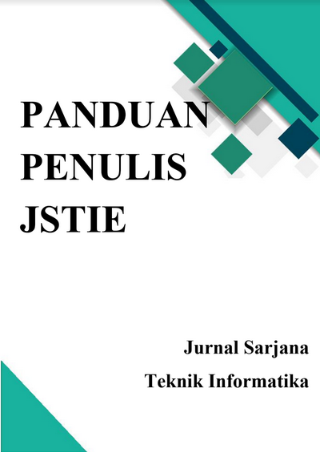Segmentasi Citra Berdasarkan Kontur Tanah Menggunakan PCA
DOI:
https://doi.org/10.12928/jstie.v12i2.28604Keywords:
Segmentasi citra Kontur Tanah Analisis Komponen Utama(PCA)Abstract
Segmentasi citra berperan penting dalam pemrosesan citra untuk pemetaan tanah, analisis lingkungan, dan aplikasi lainnya. Dalam konteks segmentasi citra berdasarkan kontur tanah, kami mengusulkan pendekatan yang memanfaatkan Analisis Komponen Utama (PCA) untuk memisahkan wilayah tanah dari latar belakang citra. Metode ini bertujuan untuk mengekstraksi fitur-fitur utama dari citra yang mencerminkan variasi intensitas piksel yang signifikan, dengan fokus pada kontur tanah. Langkah-langkah metodologi meliputi pra-pemrosesan citra, seperti normalisasi intensitas, perhitungan komponen utama, seleksi fitur, dan segmentasi berdasarkan kriteria yang ditetapkan. Penggunaan PCA membantu mengatasi masalah dimensi tinggi dalam citra dan memungkinkan ekstraksi informasi yang relevan dengan lebih efisien. Metode ini memiliki potensi aplikasi yang luas dalam pemetaan tanah untuk pertanian presisi, pemantauan lingkungan, dan analisis geologi. Kami mengevaluasi kinerja pendekatan ini menggunakan data citra tanah yang relevan, dan hasil eksperimen menunjukkan keefektifan dan keandalannya dalam memisahkan kontur tanah dari latar belakang citra dengan akurasi yang memuaskan.
References
D. descindang Irnissa, A. tiara Cahyani, H. setya Wijaya, and W. Kurniawati, “Menganalisis Batuan dan Tanah Di Permukaan Bumi,” Sci. J. Ilm. Sains Dan Teknol., vol. 1, no. 3, Art. no. 3, 2023, doi: 10.572349/scientica.v1i3.668.
M. Fauziek and A. Suhendra, “Efek Dari Dynamic Compaction (DC) Terhadap Peningkatan Kuat Geser Tanah,” JMTS J. Mitra Tek. Sipil, vol. 1, no. 2, p. 205, Nov. 2018, doi: 10.24912/jmts.v1i2.2681.
N. A. Afrianti, O. D. Andriana, A. Afandi, and W. S. Ramadhani, “Pengaruh Sistem Olah Tanah dan Pemupukan Nitrogen Terhadap Ruang Pori Tanah Pada Pertanaman Jagung (Zea Mays L.) Tahun Ke-34 Di Lahan Politeknik Negeri Lampung,” J. Agrotek Trop., vol. 11, no. 4, p. 635, Nov. 2023, doi: 10.23960/jat.v11i4.8096.
N. Nurqutni, R. Reflis, B. Sulstyo, and S. Sukisno, “Pengelolaan Daerah Aliran Sungai (DAS) Lematang Ulu Terpadu Tinjauan Literatur,” Venus J. Publ. Rumpun Ilmu Tek., vol. 2, no. 3, pp. 212–222, May 2024, doi: 10.61132/venus.v2i3.345.
N. Munir and Rinduwati, “Analisis Lahan Kritis dalam Mendukung Ketersediaan Hijauan Pakan: Review,” Bul. Nutr. Dan Makanan Ternak, vol. 17, no. 2, Art. no. 2, Oct. 2023.
A. Nurwahyunani, “Analisis Peran Petani dalam Konservasi Lahan Pertanian Berbasis Kearifan Lokal,” 2021.
I. T. Jolliffe and J. Cadima, “Principal component analysis: a review and recent developments,” Philos. Trans. R. Soc. Math. Phys. Eng. Sci., vol. 374, no. 2065, p. 20150202, Apr. 2016, doi: 10.1098/rsta.2015.0202.
E. V. Pramumardani, A. Bachtiar, and A. Arvianto, “Membangun Indeks Komposit Dalam Mengevaluasi Efektivitas Kebijakan SNI Wajib: Literature Review,” Jti Undip J. Tek. Ind., vol. 19, no. 1, pp. 46–57, Jun. 2024.
A. T. Dwilaga, “Implementasi Model Artificial Intelligence dalam Warehouse: Systematic Literature Review,” JUSTI J. Sist. Dan Tek. Ind., vol. 3, no. 2, Art. no. 2, Jan. 2023, doi: 10.30587/justicb.v3i2.5250.
B. Kumar, O. Dikshit, A. Gupta, and M. K. Singh, “Feature extraction for hyperspectral image classification: a review,” Int. J. Remote Sens., vol. 41, no. 16, pp. 6248–6287, Aug. 2020, doi: 10.1080/01431161.2020.1736732.
“Full article: A correlation change detection method integrating PCA and multi- texture features of SAR image for building damage detection.” Accessed: Jun. 30, 2024. [Online]. Available: https://www.tandfonline.com/doi/full/10.1080/22797254.2019.1630322
M. Greenacre, P. J. F. Groenen, T. Hastie, A. I. D’Enza, A. Markos, and E. Tuzhilina, “Principal component analysis,” Nat. Rev. Methods Primer, vol. 2, no. 1, pp. 1–21, Dec. 2022, doi: 10.1038/s43586-022-00184-w.
N. K. Mahanti et al., “Emerging non-destructive imaging techniques for fruit damage detection: Image processing and analysis,” Trends Food Sci. Technol., vol. 120, pp. 418–438, Feb. 2022, doi: 10.1016/j.tifs.2021.12.021.
X. Li et al., “A comprehensive review of computer-aided whole-slide image analysis: from datasets to feature extraction, segmentation, classification and detection approaches,” Artif. Intell. Rev., vol. 55, no. 6, pp. 4809–4878, Aug. 2022, doi: 10.1007/s10462-021-10121-0.
J. Zhang et al., “A comprehensive review of image analysis methods for microorganism counting: from classical image processing to deep learning approaches,” Artif. Intell. Rev., vol. 55, no. 4, pp. 2875–2944, Apr. 2022, doi: 10.1007/s10462-021-10082-4.
Downloads
Published
Issue
Section
License
License and Copyright Agreement
In submitting the manuscript to the journal, the authors certify that:
- They are authorized by their co-authors to enter into these arrangements.
- The work described has not been formally published before, except in the form of an abstract or as part of a published lecture, review, thesis, or overlay journal. Please also carefully read Journal Posting Your Article Policy.
- The work is not under consideration for publication elsewhere.
- The work has been approved by all the author(s) and by the responsible authorities – tacitly or explicitly – of the institutes where the work has been carried out.
- They secure the right to reproduce any material that has already been published or copyrighted elsewhere.
- They agree to the following license and copyright agreement.
Copyright
Authors who publish with Jurnal Sarjana Teknik Informatika agree to the following terms:
- Authors retain copyright and grant the journal right of first publication with the work simultaneously licensed under a Creative Commons Attribution License (CC BY-SA 4.0) that allows others to share the work with an acknowledgement of the work's authorship and initial publication in this journal.
- Authors are able to enter into separate, additional contractual arrangements for the non-exclusive distribution of the journal's published version of the work (e.g., post it to an institutional repository or publish it in a book), with an acknowledgement of its initial publication in this journal.
- Authors are permitted and encouraged to post their work online (e.g., in institutional repositories or on their website) prior to and during the submission process, as it can lead to productive exchanges, as well as earlier and greater citation of published work.








